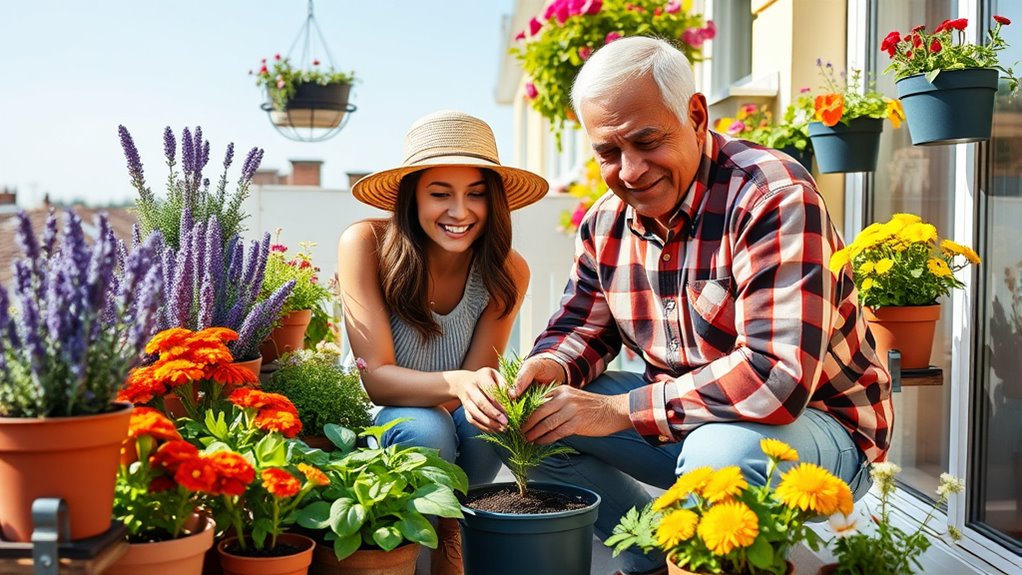Even with no yard, you can create a vibrant mini pollinator garden using containers like pots, window boxes, or hanging baskets placed in sunny spots. Choose native plants that bloom at different times to provide continuous food and attract bees, butterflies, and other beneficial insects. Incorporate simple nesting options such as bee hotels or hollow stems. Grouping plants and adding colorful flowers will boost pollinator visits. Keep exploring to discover more ways to support local ecosystems indoors.
Key Takeaways
- Use containers like pots, window boxes, or hanging baskets placed in sunny spots to create a portable pollinator garden.
- Select native, flowering plants that bloom at different times to provide continuous food sources for pollinators.
- Incorporate herbs, wildflowers, and native perennials in bright colors such as purple, yellow, and blue to attract bees and butterflies.
- Add nesting structures like bee hotels or hollow stems to support pollinator habitats in small spaces.
- Group similar plants together and arrange them to mimic natural habitats, maximizing pollinator attraction and ease of maintenance.

Creating a mini pollinator garden is a simple and rewarding way to support local bees, butterflies, and other beneficial insects. Even if you don’t have a yard, you can still create a thriving environment for pollinators in small spaces like balconies, patios, or windowsills. The key is thoughtful garden design—choosing the right plants, containers, and placement to maximize their appeal and effectiveness. When planning, consider which pollinator species are native to your area; this ensures your garden attracts the right insects and provides the resources they need. Native plants are naturally adapted to local conditions, making them easier to grow and more beneficial for pollinators.
Start by selecting a variety of plants that bloom at different times of the year, ensuring a continuous food source. Bright colors like purple, yellow, and blue tend to attract more pollinators, so choose flowers that fit this palette. Incorporate a mix of flowering herbs, wildflowers, and native perennials that are suited to your climate and space constraints. Container gardening offers flexibility—use pots, window boxes, or hanging baskets to create a mini habitat. Position these containers in a sunny spot, ideally receiving at least six hours of direct sunlight daily, since most pollinators are active during warm, sunny weather.
In your garden design, prioritize diversity. A variety of plant types and structures provides shelter and nectar for different pollinator species. Include plants with accessible nectar and pollen, and add structures like small bee hotels or hollow stems to encourage nesting. Consider the height and arrangement of your plants to mimic natural landscapes, which are more inviting to pollinators. Grouping similar plants together can also increase their attractiveness and make for easier maintenance. Additionally, understanding the role of native plants in supporting local pollinator populations can significantly enhance your garden’s success.
Frequently Asked Questions
Can Mini Pollinator Gardens Attract Native Pollinators?
Yes, mini pollinator gardens can attract native pollinators. By focusing on native plant selection, you support local pollinator diversity, which is vital for ecosystem health. Even small gardens provide essential nectar and pollen sources, encouraging native bees, butterflies, and other pollinators to thrive. Your efforts help sustain these important species, promoting a balanced environment and increasing pollination success for nearby plants.
What Are the Best Plants for Small or Indoor Gardens?
When choosing plants for small or indoor gardens, focus on container gardening options that thrive in limited space. Select compact, easy-to-maintain plants like succulents, herbs, or small flowering varieties such as violets and African violets. For indoor planting, make certain your plants get enough light and water. These versatile choices brighten your space and support your gardening goals, even if you don’t have a yard, making your indoor environment lively and inviting.
How Often Should I Water My Mini Pollinator Garden?
You should water your mini pollinator garden regularly, following a consistent watering schedule to keep the soil moist but not soggy. Since many pollinator-friendly plants have good drought tolerance, you can reduce watering frequency once they’re established. Check the soil moisture often—water when the top inch feels dry. Adjust your watering schedule based on weather conditions, ensuring your garden stays healthy and attracts pollinators effectively.
Are There Eco-Friendly Ways to Maintain the Garden?
Did you know that eco-friendly gardens can attract 30% more pollinators? To maintain yours sustainably, try composting techniques to enrich your soil naturally, reducing waste and chemical use. Use organic pest control methods like neem oil or beneficial insects instead of chemicals. These practices protect pollinators and the environment, ensuring your garden stays healthy and vibrant without harming nature. It’s easy to make eco-conscious choices that benefit everyone.
Can a Mini Garden Support Local Bee Populations?
A mini garden can support local bee populations, especially by creating urban habitats that provide essential nectar and shelter. You can help mitigate the pesticide impact by choosing native, pesticide-free plants and avoiding chemicals. Even in small spaces, your efforts boost bee health and diversity. By planting thoughtfully, you contribute to a thriving ecosystem, encouraging bees to thrive and pollinate both urban and surrounding natural environments effectively.
Conclusion
By planting a mini pollinator garden, you can support crucial pollinators like bees and butterflies right from your balcony or windowsill. Did you know that over 75% of flowering plants depend on pollinators? Even with limited space, your small garden can make a big difference. So go ahead—choose native plants, add a few blooms, and enjoy watching nature thrive right outside your door. Every little bit helps in protecting these essential creatures!










